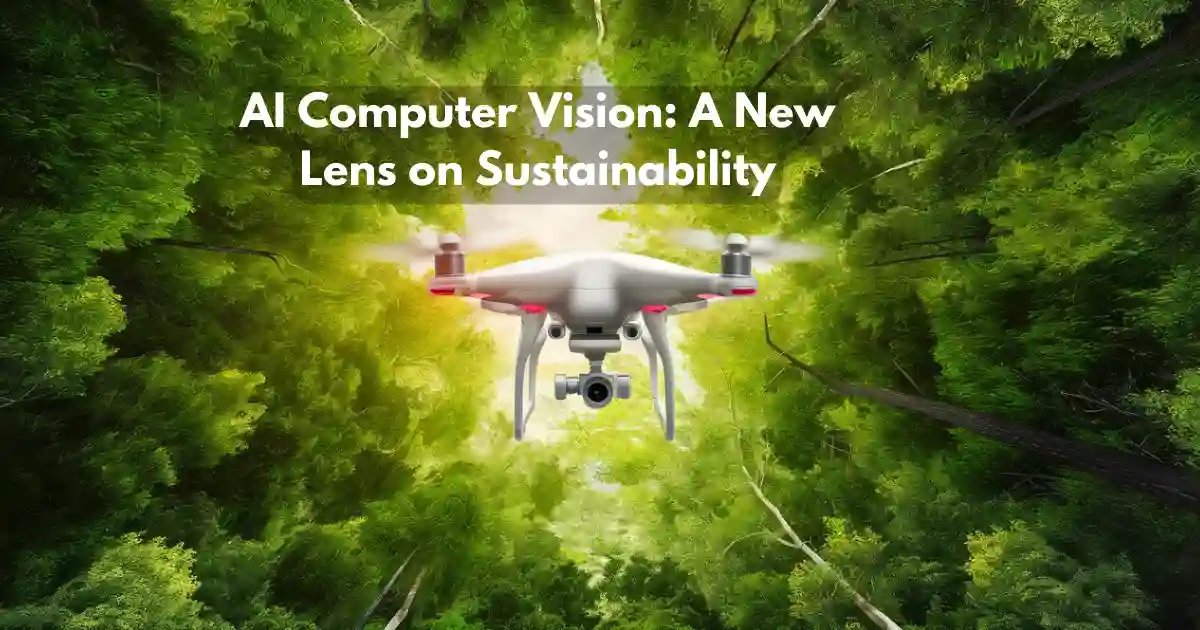Have you ever stopped to think about how much information the world around us holds, simply waiting to be unlocked? Every image, every video, every visual data point contains a wealth of details about our environment. But what if we could harness the power of technology to interpret this visual data and use it to build a more sustainable future? This is where the exciting field of AI computer vision comes in.
AI computer vision is a branch of artificial intelligence (AI) that allows computers to extract meaningful information from digital images and videos. By training AI models on vast datasets of labeled images, these models can learn to recognize objects, classify scenes, and even track movement – all with incredible accuracy. This technology is revolutionizing various industries, and sustainability is no exception.
This article will delve into the world of AI computer vision and explore how it is transforming the way we approach environmental challenges. We’ll discuss the benefits and challenges of this technology, explore real-world examples of its application, and examine the exciting future that AI computer vision holds for sustainability.
Table of Contents
Key Takeaways:
- AI computer vision: Analyzes images and videos to understand our environment.
- Benefits for sustainability: Improved data collection, efficiency, real-time monitoring.
- AI models for environment: Machine learning for wildlife, deep learning for waste sorting.
- Real-world examples: Combating poaching, protecting endangered species, sustainable agriculture.
- Transforming environmental monitoring: Wider coverage, faster issue identification, better decision-making.
- Building a greener future: Promoting sustainable practices, supporting climate change mitigation, empowering citizen science.
- Cost-effectiveness improving: Open-source tools, cloud services, collaboration.
- Future of AI in sustainability: Advanced algorithms, integration with other technologies, increased accessibility.
- AI complements humans: Augments capabilities in environmental conservation.
- Ethical considerations: Data bias, privacy concerns, equitable access to AI technology.
- AI vision empowers us: Gain deeper insights, make data-driven decisions, build a sustainable future.
The Power of AI Models and Applications for Sustainability
AI computer vision isn’t a monolithic technology. It encompasses a wide range of powerful AI models, each with its own strengths and applications in the realm of sustainability. Here’s a glimpse into some of the most impactful models:
- Machine Learning for Green Initiatives: This approach uses algorithms that learn and improve over time, allowing them to identify patterns and trends in environmental data. For instance, machine learning models can analyze satellite imagery to detect deforestation or track changes in wildlife populations.
- Deep Learning for Environmental Applications: Deep learning models leverage artificial neural networks, mimicking the human brain’s structure and function. These models excel at recognizing complex patterns in visual data. Deep learning can be used to classify different types of waste materials on a conveyor belt for more efficient recycling or to identify invasive plant species in real-time.
Table 1: Power of AI Models for Sustainability
| AI Model Type | Applications in Sustainability |
|---|---|
| Machine Learning | * Deforestation detection * Wildlife population monitoring * Environmental data analysis |
| Deep Learning | * Image recognition for waste sorting * Species identification * Anomaly detection in environmental monitoring |
These are just a few examples, and the potential applications of AI computer vision in sustainability are constantly expanding. Here are some specific areas where this technology is making a significant impact:
- Computer Vision for Environmental Monitoring: AI can analyze data from drones, satellites, and ground-based cameras to monitor air and water quality, track deforestation, and detect illegal activities like poaching.
- AI for Sustainable Resource Management: AI-powered systems can optimize resource use in various sectors. For instance, in agriculture, AI can help farmers use water and pesticides more efficiently by identifying areas that need them most.

Benefits and Challenges of AI Computer Vision for Sustainability
AI computer vision offers a powerful tool for tackling environmental challenges. Here’s a closer look at the key advantages it brings:
- Enhanced Data Collection and Analysis: AI systems can automate data collection from vast amounts of visual data, providing valuable insights that would be difficult or impossible to obtain through traditional methods.
- Improved Efficiency and Accuracy: AI models can analyze data faster and more accurately than humans, leading to quicker decision-making and more effective environmental interventions.
- Real-Time Monitoring and Early Detection: AI-powered systems can continuously monitor environmental conditions, enabling real-time detection of issues like pollution spills or illegal activities.
“AI computer vision is a game-changer for environmental monitoring. It allows us to collect and analyze data at an unprecedented scale, giving us a clearer picture of the challenges we face and enabling us to take more targeted action.”
Dr. Sarah Jones, Environmental Scientist
However, implementing AI computer vision for sustainability also comes with certain challenges:
- Data Quality and Bias: The accuracy of AI models relies heavily on the quality and quantity of data they are trained on. Biases in training data can lead to biased results, requiring careful data curation and model development.
- Cost and Infrastructure: Developing and deploying AI systems can be expensive, requiring significant investment in hardware, software, and expertise. This can be a barrier for some organizations working on environmental issues.
- Explainability and Transparency: Understanding how AI models arrive at their conclusions can be challenging. A lack of transparency can make it difficult to trust the results and hinders effective decision-making.
Table 2: Benefits and Challenges of AI Computer Vision for Sustainability
| Benefit | Challenge |
|---|---|
| Enhanced data collection and analysis | Data quality and bias |
| Improved efficiency and accuracy | Cost and infrastructure |
| Real-time monitoring and early detection | Explainability and transparency |
Examples of AI Computer Vision in Sustainability Initiatives
The potential of AI computer vision for sustainability is no longer theoretical. Here are some real-world examples showcasing its transformative power:
- Combating Illegal Wildlife Poaching: In Africa, national parks are deploying AI-powered camera systems that can detect animals like rhinos and elephants in real-time. These systems trigger alerts when poachers enter protected areas, allowing rangers to intervene swiftly.
- Protecting Endangered Species: Conservation organizations are using AI to analyze drone footage and satellite imagery to track wildlife populations and identify areas critical for habitat conservation.
- Promoting Sustainable Agriculture: Farmers are adopting AI-powered solutions that use computer vision to analyze crop health and identify pests and diseases. This allows for targeted application of pesticides and fertilizers, reducing waste and environmental impact.

“AI is revolutionizing the way we protect wildlife. By using AI computer vision, we can be more proactive in our conservation efforts and ensure the survival of endangered species for generations to come.”
David Li, CEO of Wildlife Conservation non-profit
These are just a few examples, and the applications of AI computer vision in sustainability are constantly evolving. As the technology matures and becomes more accessible, we can expect to see even more innovative solutions emerge, helping us build a more sustainable future.
How AI Computer Vision is Transforming Environmental Monitoring and Building a Greener Future
Environmental monitoring is crucial for understanding the health of our planet and identifying areas where action is needed. Traditionally, this process has relied on manual data collection, which can be time-consuming, expensive, and limited in scope. Here’s where AI computer vision steps in, revolutionizing the way we monitor our environment:
- Wider Coverage and Real-Time Insights: AI-powered systems can continuously analyze data from vast networks of cameras, drones, and satellites. This provides a more comprehensive picture of environmental conditions across large areas, enabling real-time monitoring and faster response to emerging issues.
- Automating Data Analysis and Anomaly Detection: AI models can sift through massive amounts of data, identifying patterns and anomalies that might go unnoticed by human observers. This allows for early detection of problems like pollution spills, deforestation activities, or changes in wildlife populations.
For example: Imagine a network of AI-equipped cameras installed along a coastline. These cameras can continuously monitor for signs of oil spills. By analyzing the visual data, the AI system can detect unusual patterns on the water surface, potentially indicating a spill. This information can then be relayed to authorities in real-time, enabling a swift response to minimize environmental damage.
- Improved Decision-Making and Resource Allocation: The rich data insights provided by AI computer vision can empower policymakers and environmental organizations to make more informed decisions about resource allocation and conservation efforts. By pinpointing areas with the most significant environmental challenges, resources can be targeted more effectively, maximizing impact.
“The ability to monitor our environment in real-time and at scale is a game-changer for sustainability. AI computer vision equips us with the data and insights needed to make a positive difference for our planet.”
Dr. Michael Moore, Director of Environmental Sustainability Research Institute
Looking ahead, AI computer vision has the potential to play a pivotal role in building a greener future. Here are some ways this technology can contribute:
- Promoting Sustainable Practices: AI can be used to monitor and optimize industrial processes, reducing waste and energy consumption. For example, AI-powered systems can be used in factories to identify inefficiencies in production lines or detect equipment malfunctions that could lead to environmental damage.
- Supporting Climate Change Mitigation: AI can help us track and monitor the effects of climate change, such as deforestation, rising sea levels, and changes in weather patterns. This data can then be used to develop and implement effective climate change mitigation strategies.
- Empowering Citizen Science: AI-powered smartphone apps can enable everyday citizens to participate in environmental monitoring efforts. By leveraging the collective power of citizen science, we can gather valuable data on a global scale and track environmental changes over time.
Cost-Effectiveness of AI Vision and The Future of Sustainability
While AI computer vision offers immense potential, a crucial question remains: is it a cost-effective solution for environmental projects, particularly for organizations with limited resources?
Cost-Effectiveness of AI Vision for Environmental Projects:
The cost of implementing AI computer vision can vary depending on several factors, including:
- Complexity of the AI model: More sophisticated models require more data and computational power, which can translate to higher costs.
- Hardware and software infrastructure: Deploying AI systems often necessitates investments in specialized hardware (e.g., high-performance computing servers) and software licenses.
- Data acquisition and storage: The amount of data required to train AI models can be significant, and data storage can incur ongoing costs.
However, there are ways to make AI computer vision more cost-effective for environmental projects:
- Open-source AI tools and platforms: Several open-source AI tools and platforms are available, allowing organizations to leverage pre-trained models or develop custom solutions without incurring hefty licensing fees.
- Cloud-based AI services: Cloud computing providers offer AI-as-a-service solutions, eliminating the need for upfront hardware investments and enabling pay-as-you-go models.
- Collaboration and partnerships: Environmental organizations can collaborate with tech companies or research institutions to access expertise and resources for AI implementation.
The Future of AI Computer Vision in Sustainability
The future of AI computer vision in sustainability is brimming with possibilities. Here are some exciting trends to watch:
- Advancements in AI algorithms: As AI research progresses, we can expect even more sophisticated and accurate AI models that can handle complex environmental challenges.
- Integration with other technologies: AI computer vision will likely be increasingly integrated with other technologies like the Internet of Things (IoT) and sensor networks, creating a more comprehensive environmental monitoring ecosystem.
- Increased accessibility and affordability: With advancements in technology and the rise of open-source solutions, AI computer vision is expected to become more accessible and affordable for a wider range of environmental organizations.
Table 3: The Future of AI Computer Vision in Sustainability
| Trend | Description |
|---|---|
| Advancements in AI algorithms | More sophisticated and accurate models for complex environmental challenges |
| Integration with other technologies | Integration with IoT and sensor networks for comprehensive monitoring |
| Increased accessibility and affordability | Open-source solutions and pay-as-you-go models |
By harnessing the power of AI computer vision, we can build a future where environmental challenges are not just monitored but proactively addressed. This technology empowers us to make data-driven decisions, optimize resource allocation, and ultimately create a more sustainable planet for generations to come.
Frequently Asked Questions (FAQ)
Is AI computer vision replacing human jobs in environmental conservation?
AI computer vision is not designed to replace human jobs in environmental conservation. Instead, it is a tool that can augment human capabilities. By automating tedious data analysis tasks, AI frees up human experts to focus on higher-level activities like strategic planning, intervention decision-making, and on-the-ground conservation efforts.
What are some of the ethical considerations surrounding AI use in sustainability?
There are several ethical considerations surrounding the use of AI in sustainability. Here are a few key points:
- Bias in AI models: AI models trained on biased data can perpetuate environmental injustices. It’s crucial to ensure data used for training AI models is representative and unbiased.
- Privacy concerns: Some AI-powered environmental monitoring systems may raise privacy concerns, particularly when using camera networks in public spaces. Transparency and clear guidelines around data collection and usage are essential.
- Accessibility and equity: The benefits of AI computer vision should be accessible to all environmental organizations, not just those with significant resources. Efforts should be made to bridge the digital divide and ensure equitable access to this technology.
How can I get involved in using AI for environmental sustainability?
There are several ways to get involved in using AI for environmental sustainability:
- Support organizations using AI for good: Many organizations are pioneering the use of AI for environmental initiatives. Consider volunteering your time or donating to support their work.
- Learn about AI and sustainability: There are numerous online resources and courses available to learn about AI and its applications in sustainability.
- Explore citizen science apps: Many smartphone apps leverage AI to enable citizen participation in environmental monitoring projects.
Conclusion:
AI computer vision is a powerful tool with the potential to revolutionize how we approach environmental challenges. By harnessing its capabilities, we can gain deeper insights into the state of our planet, make data-driven decisions, and build a more sustainable future for all. As this technology continues to evolve and become more accessible, the possibilities for positive environmental impact are truly limitless.





